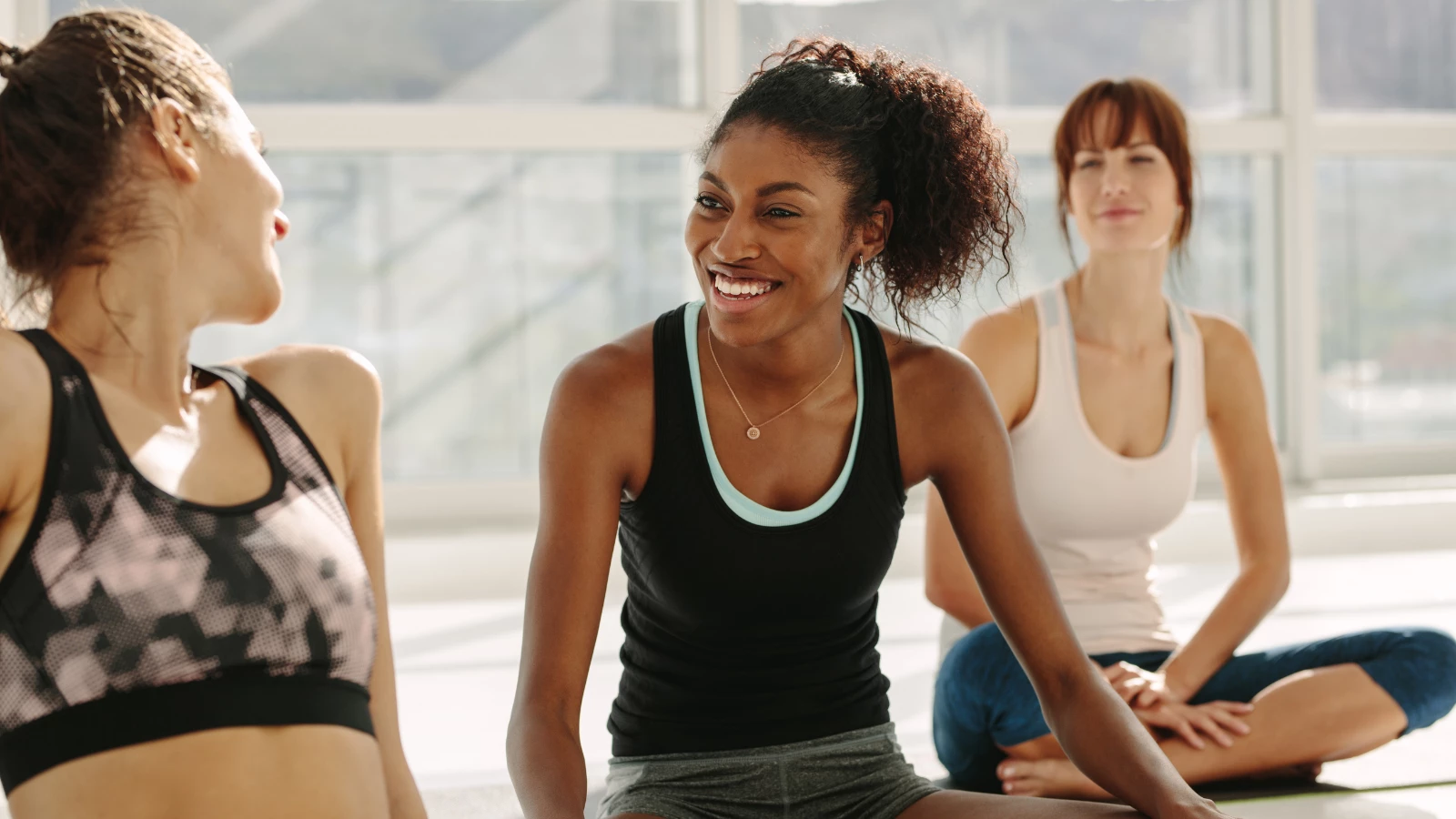The Yoga of Co-Regulation: Group Yoga Class Benefits

Article At A Glance
Do you enjoy socializing with yoga? Could group yoga class benefits include feeling better simply through social connection? Picture the following situation. You enter your favorite yoga studio. It’s serene, familiar, and comforting. You share pleasantries with the front desk attendant as you check in and with fellow yogis as you settle into class while you roll out your mat and set up your props. Did you realize these are examples of co-regulation?
As you flow through postures during class, that sense of connection begins to grow from the moment you walk in—it only deepens. In fact, it becomes embodied. Stephen Porges’ Polyvagal Theory posits that we can best balance our nervous system in the community. Others regulating themselves in our company helps us to regulate ourselves, and vice-versa.
Yoga classes can also offer a space to challenge ourselves within a safe container. This provides opportunities to hone our nervous system’s ability to work together in dynamic balance. As with much of yoga’s magic, more research is necessary for us to empirically understand these effects. Yet what we do know points us in some encouraging directions.
1. Polyvagal Theory and Co-Regulation: Healing in Community
Polyvagal Theory is multifaceted and complex. Focusing on how group yoga classes can help us feel more settled and integrated, a few concepts within the theory are salient. Polyvagal Theory involves the anatomy and physiology of the vagus nerve, which has a key role in the functioning of many key organs. As such, interoception, one’s sense of the body’s inner workings and sensations, is closely interrelated with the vagus nerve and Polyvagal Theory.
Yoga can hone our interoception with space, time, and encouragement to key into the body’s messages. As that sense gets stronger, we can leverage the vagus nerve’s central place in the ebbs and flows of our nervous system. Indeed, the vagus nerve is a key part of the autonomic nervous system, which includes both our “fight/flight/freeze” (sympathetic) and “rest/digest” (parasympathetic) mechanisms.
Additionally, a fundamental part of Polyvagal Theory is co-regulation: that aforementioned feedback loop of us settling our nervous system, helping those around us settle their nervous system, and others doing the same for us. This process occurs through our very biology. It evolved to help us survive together in groups over the course of millennia (1).
“To connect and co-regulate with others is our biological imperative. We experience this imperative as an inherent quest for safety that can be reached only through successful social relationships in which we co-regulate our behavior and physiology,” Porges himself once affirmed.
2. The Nervous System In Balance: Group Yoga Class Benefits
Yoga can be a laboratory, with respect to ourselves but also to ourselves in community, where we experiment, investigate, and learn. As we face challenges in our practice, alongside others facing challenges, we learn about ourselves with others as we all encounter life’s difficulties.
We learn to be less attached, less judgmental, and more open to what each moment might bring. We see this more anecdotally than empirically—for now. Perhaps as yoga research broadens and deepens, we’ll understand more rigorously how yoga interacts with sociality (2).
In any case, Polyvagal Theory would indicate this much: as we see each other smiling and laughing in the face of yoga practice challenges, hear each other sighing out deeply at our instructor’s cue, and feel each other letting our mats receive us as we settle into the final restful poses of class, co-regulation buzzes through the room, whether we are aware of it or not.
Another important aspect of Polyvagal Theory is that when we are in balance, the parts of the autonomic nervous system are in dynamic give and take. No part of the system is “good” or “bad.” Rather, problems arise when one dominates over the others, and we become stuck in that state.
Yoga classes help us learn what it feels like for our nervous system to be in dynamic balance. We also learn the tools that it takes to get us there. The challenges and exertion that we face in class—pushing our “growing edge”—pique the sympathetic nervous system. Rest and the safety of the welcoming space target our parasympathetic nervous system.
These mechanisms begin to dance together more fluidly as we flow and breathe, exert ourselves and find more easeful moments. In group yoga classes, we balance our own nervous system alongside others doing the same, and co-regulation permeates. At the same time, we may very well—consciously or unconsciously—learn more about how that can happen outside of the yoga studio, as well.
3. Nurturing Co-Regulation as Students: Yoga and Community
In most cases, it does seem as if co-regulation occurs as we regulate our nervous systems side by side in most group yoga classes. Yet how can we facilitate that process? How can we make it even stronger and more fruitful?
As students, we can:
- Reach out to fellow students with a smile and a hello, if it feels appropriate, by what you can sense about where others are (and also where we are!). On some days, we’d rather not socialize, and, of course, that’s okay. Yet, in many cases, a little intentional connection can allow us to engage in ways that we might not have thought possible.
- Support each other. We can cheer each other on when attempting challenging asana and offer any potential helpful tips—within the bounds of good class etiquette. Our yoga journey is a personal one. At the same time, moving forward in our separate practices feels better in a community. Even on our own separate paths, we can help each other step forward!
4. Creating Co-Regulation in Your Classes: Making it a Group Yoga Class Benefit
As instructors, we can:
- Offer space for students to engage with each other within a welcoming class atmosphere. Things like telling students to turn to each other and say hello at the beginning of class can feel a little hokey but may resonate with some students and in some contexts. More subtly, you can encourage students to embrace the awkward moments that can open space for connection. Examples might include when they inadvertently face each other because one person took a different side in a flow or a pose or when someone knocks over a water bottle (we’ve all been there!).
- Within appropriate bounds of etiquette, allow students to verbalize their experiences. For example, ask them how they’re feeling at periodic points in class and/or work on challenging poses in a workshop-like atmosphere, with different students sharing and troubleshooting. Keep the energy light by encouraging students not to take it all so seriously. It’s not about the big fancy pose but the process and energy that we bring to get there.
- In times before and after class, offer open space for students to connect with you and each other, to the extent that you can offer that. Yes, we yoga instructors often have packed schedules, but even five minutes of time after class can help foster connection. This can build upon the embodied and more overt connection that might have begun to build through the course of class. Before class, opening that same sort of space can spread even more fertile soil from which connections can bloom throughout the class to come. Students can share things like injuries and other physical needs.
5. Seeking Group Yoga Class Benefits: When We Choose In-Person Yoga Classes
No doubt, many yogis missed sharing space with their yoga friends during COVID lockdowns. Many studios and instructors shifted to virtual formats: Zoom, Twitch, Instagram Live, and YouTube. That allowed people to keep practicing and keep practicing together in some way. Yet it just wasn’t the same. That dynamic is certainly in no way exclusive to yoga. Yet maybe, just maybe, the embodied co-regulation of group yoga classes was a unique and profound casualty of COVID lockdowns.
Now, in 2022, many studios and gyms are back open. Some studios and instructors have kept virtual options open. That keeps access to their classes wider and more inclusive. This keeps practice available to those living in other regions, to those who can’t travel, to the immunocompromised, and to those who feel more secure practicing in their homes.
If we can’t make it to a group class, a 20-minute home practice with a YouTube video is better than no practice at all. Private or semi-private classes allow for highly personalized instruction. Digital offerings also allow us to practice and study with master teachers and/or those who specialize in yogic disciplines that we may be particularly interested in.
The Joy of Co-Regulation in Group Yoga Classes
Yet that energetic resonance of a group yoga class—people breathing and moving together, maybe even supporting each other, smiling and laughing—there’s nothing quite like it. The positive thing is that most often, it doesn’t have to be an either/or. We can combine individual and group practices in the ways that are feasible for us, and best serve us.
As we travel our individual yoga paths, each step is a choice. We balance what’s possible for us and where our souls call us. Then we make the best choices that we can at each juncture. Whether we choose a solo practice, group yoga practice, or a combination of both, may we choose and step forward mindfully.
Also, read...
Yoga to Soothe Mind and Body: How to Practice Supported Pigeon Pose
Study: Yoga Can Help Foster Greater Mind-Body Integration – The Four Stages of Body Awareness
Related courses

Kathryn Boland is an RCYT and R-DMT (Registered Dance/Movement Therapist). She is originally from Rhode Island, attended The George Washington University (Washington, DC) for an undergraduate degree in Dance (where she first encountered yoga), and Lesley University for an MA in Clinical Mental Health Counseling, Expressive Therapies: Dance/Movement Therapy. She has taught yoga to diverse populations in varied locations. As a dancer, she has always loved to keep moving and flowing in practicing more active Vinyasa-style forms. Her interests have recently evolved to include Yin and therapeutic yoga, and aligning those forms with Laban Movement Analysis to serve the needs of various groups (such as Alzheimer’s Disease patients, children diagnosed with ADHD, PTSD-afflicted veterans – all of which are demographically expanding). She believes in finding the opportunity within every adversity, and doing all that she can to help others live with a bit more breath and flow!
Resources
- Porges, Stephen W. “Polyvagal Theory: A biobehavioral journey to sociality.” Comprehensive Psychoneuroendocrinology, Volume 7. <https://www.sciencedirect.com/science/article/pii/S2666497621000436>. 2021 August.
- Leikola, Anssi et al. “Polyvagal Theory and Emotional Trauma.” Duodecim. <https://pubmed.ncbi.nlm.nih.gov/27044181/>. 2016.
- https://www.sciencedirect.com/science/article/pii/S2666497621000436
- https://pubmed.ncbi.nlm.nih.gov/19376991/








